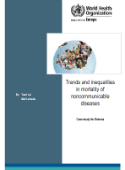Trends and inequalities in mortality of noncommunicable disease. Case study for Estonia (2016)

Download
This case study aims to provide a comprehensive overview of trends and inequalities in mortality of noncommunicable diseases in Estonia over the first decade of the 2000s. Decomposition of life expectancy by causes and age groups, and calculation of age-standardized rates for total and cause-specific mortality were used to assess differences over time and across social groups.
The findings of the analysis showed significant overall reduction in mortality and increasing life expectancy in Estonia during the 2000s. The considerable improvement in mortality was observed in all groups distinguished by gender, ethnicity, educational level or by place of residence resulting in narrowing absolute inequalities, although the relative inequalities by educational level and by place of residence slightly increased.
Despite progress, mortality rates remained higher among non-Estonians, the lower educated and residents of Ida-Viru county. Circulatory diseases and external causes of death contributed the most to the overall life expectancy at birth improvement and to the larger mortality decline among non-Estonians, the lower educated and in Ida-Viru county, with the opposite effect seen for infectious diseases.



